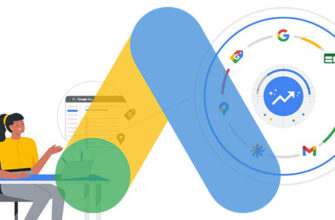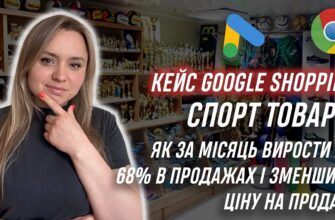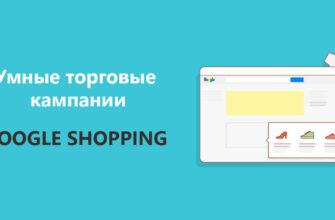- Brief overview of the case
- What is the complexity of the project?
- What was launched in the project, period, settings, budget
- The time it takes for the performance to start working steadily
- Adding self-study performance tests
- Characteristics of tests to be performed
- What did we launch in this case study campaign?
- Add-to-cart conversion – should or shouldn’t be used
- Period during which the performance shows the results of setting changes
- Editing of signals by auction statistics
- Achievement of client’s KPIs during the cooperation period
- Why does performance art need more analytics?
- Launching a campaign without objects
- Effectiveness of launching campaigns with or without objects
- What changed in the advertising campaign in the larger period?
- What do you need to focus on to understand movement in the right direction?
- Fake orders
- Parsing the auction stats why you can’t grow
- Results
Hi everyone, my name is Yana Lyashenko. I work as a logistician at Google. And in today’s video, I’m going to show you one of the cases. Maybe let’s call it a case study explanation. It will be of interest to both professionals and businesses that expect certain results from a team, agency or specialist.
Brief overview of the case
What do we have? We have a wood decor product. We have a market in the UK. And in our case, we worked with this project for almost a month, four weeks, I think. Then the client went on to work with another team. Now I am explaining what the situation is here, what was launched here, and what the difficulty was.
What is the complexity of the project?
And the first difficulty is the UK market. You have to realize that the UK is the pioneer of e-commerce in Europe. And if it is the pioneer of e-commerce, it means that it is not the easiest market for sales at all. Not only that, but I will say that it is not the easiest market for sales in general for almost any niche. There are a lot of specific nuances here, starting with the very mechanics of user behavior, which differs from a German or an Italian or a Pole, and ending with the nuances of competition. Because we also had here at this point, and perhaps it has also continued now, another rather significant large competitor, which we were oriented towards.
How many calls and sales will I get by ordering contextual advertising from you?
I need to calculate the conversion of my website Describe
the task
in the application
Calculate potential ad revenue Google
contextual advertising calculator
What was launched in the project, period, settings, budget
What was the trigger here? One of the nuances was that we had a rather limited budget, only 35 dollars a month. Plus we have a start date, we take into account that this is not an Orthodox region, but a region where there is a pre-holiday period. For example, somewhere before December 18-20, there is still some gift buying going on. Then there is a relative lull, and by some January holidays it begins to recover a little bit in turnover.
Well, it is Catholics, for example, if you face them in the general dynamics, they have very common features. We launched just in the period, we had our first clicks here on December 7th. And well, we’re somewhere between now and January 4th, I think we have. Well, I’ve got January 4th in my task order. Probably a little bit longer these ad campaigns have been running on the helpdesk.
What do we have? So we are launching in a very difficult market, with very high competition. This market is quite specific in terms of the buying model itself. Plus there is the fact that, in principle, it is very difficult for small budgets to try to achieve very significant turnover very quickly. Because if we’re talking about the UK market or some specific niches in the States, like clothing or underwear, something like that, you have to be prepared that it can take a significant period of time for performances to get off the ground.
The time it takes for the performance to start working steadily
And that significant period of time, if you’ve been following my channel for a long time, you know it averages 30 to 90 days. On average, it takes three months to stabilize a performance. Why this period? Because, for example, how do we do it? We’ll have initial tests to identify what traffic is or isn’t right for us. The next thing is to try to scale up in the next accounting period. I will not describe it, so that then it will not be rammed around the Internet like our figures from the cases. The next thing is to try to scale what we got during the first tests, because we have a zero account. And in parallel, we will start more tests on microbudgets, and then we will use the same technology again. In three months we can reach plus or minus more or less stable turnovers. One.
Two. Form the backbone of advertising campaigns that do not need to be defined in traffic. Achieve conversions only through these shoots. This is already a more or less stable set of advertising campaigns that are already working, generating a certain result. Then you simply add more.
Adding self-study performance tests
The nuances in this strategy is that you have to be careful about adding tests, additional campaigns. You absolutely have to have prioritization in the campaigns that you run in your tests. Why? Because you have to understand that performances are campaigns that use artificial intelligence in addition to machine learning.
As we all know, if anyone doesn’t know, artificial intelligence can self-learn from the database provided. Your database is everything that starts from the first click, all the behavioral characteristics of a person. Of course, you have to specify them for the system. Google does not just take them out of the blue. It all has to be set up technically in order for it to work correctly. What happens from the first click is the mechanics, the model of the database. It acts as a database on which artificial intelligence then models various targeting schemes or audience search according to the algorithms that are embedded in it.
It may seem super obvious. And when it comes to work, for some people, it’s not super obvious, for example. Smartshopping, it didn’t just use machine modeling. That’s why it was so effective. Performance is another type of artificial intelligence targeting that has to work here. We are now going to look at such nuances, what affects or does not affect what, using the example of the next few months of this project, so that it can be useful information and analysis for someone.
Characteristics of tests to be performed
So if we know that after the first click some database is already being collected, then we need to conduct new tests that are not significant enough in the cost part or not influential enough on our main indicators that we have achieved before, if they were plus or minus effective for us. What does that mean by not influential enough? If, for example, we have collected the number of some conversions targeted, non-targeted and, for example, views of product cards. They brought us some small result, you need to understand that all that in the account for a month up to 60 somewhere on average conversions, there 50 help, writes somewhere 60 – it is not statistically significant at all. I mean for a month. It makes no difference to the system at all what you had last month, or the month before, or last year. Everything is taken only up-to-date, for the last 30 days, and moreover, everything that shifts to the date of our last actuality is taken into work for the analysis of the system itself. How does this affect the performance of all these performances?
The less analytics we collect, the less volatile it is. We remember that the UK market, it’s quite complex. Well, you can’t get away from it. You can launch the same product, for example, France, Germany. And these two countries together will give a very super profit, unlike the UK. But the UK is also a stable, solvent, expensive piece of the market, where you can spin and where you can catch all these sales. But because of the very high competition there, there are local specifics of the auction, which Performance Max also takes into account. Because we don’t just set the geography with you. Not just to show our ads. It also incorporates all this into its algorithms in order to predict which auctions to enter, at what moment. The date, device, and so on are all taken into account.
Each local market has its own peculiarities. Ukraine has its own, Poland its own, the States its own, Australia in general it is coded from the world with New Zealand. So you have to take that into account.
If we have very little statistical data on conversions, then your fills are very large tests, they can spoil the model of further training of this artificial intelligence on the basis of that small number of conversions.
In general, of course, the more of these conversions, the more of them there are 500 and more in a month, the more stable it is, of course, and that’s not a fact. Even in projects where there are 300-400 sales per day, there are certain unstable situations, especially when you have to fit into a certain price per conversion. So we took this into account.
What did we launch in this case study campaign?
We’ve run a pretty significant number of campaigns here. We’ve only had four weeks and we’d like to test, well, quite a variety of targeting. If you properly prioritize between ad campaigns using budget profitability, signals, and structure, respectively, then in the first two weeks, performances try to work fairly within their signals. It’s somewhere roughly like this. Two weeks is a conditional figure. It all depends on the volume of traffic, the budget you give to these advertising campaigns.
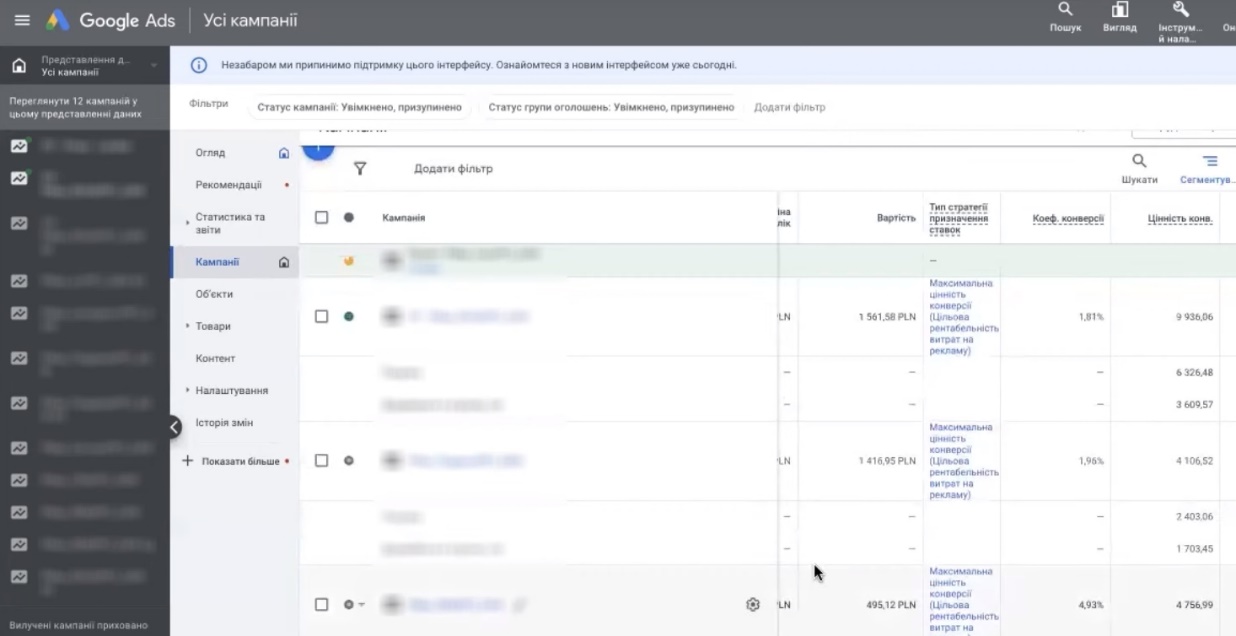
I remind you that we had a fairly limited budget – $35 per day. That’s not that much money in general for the amount of campaigns that we were running. What we had here, and targeting on specific dynamic remarketing lists, on gift targeting. Because this is just the December period, we would have a task, maybe we could catch these conversions there. But you have to understand that during the Christmas period, the whole auction is overheated, especially the UK. There were various combinations of different targeting, signals, even competitors. Well, we didn’t have time to finish, let’s say, the competitors.
Add-to-cart conversion – should or shouldn’t be used
Here a certain priority of targeting has been drawn out. Not only that, here in the first period, here until December 14, you can see here that there are significantly more conversions. This is due to these conversions of adding to the cart. I’m going to explain why we added them. It’s more of a technical component. I generally do not recommend adding this conversion rate to the main goals for which the performance will be optimized. For the simple reason that most likely you will not be able to cope with the moment when you have to get off of it.

You can add it, any goals you want can be added to the performances. It doesn’t have algorithms sewn into it to increase your ROI or your profitability. It even has these metrics called conversion value. Profitability is called conversion value per conversion value, not called sales. So you can add whatever conversions you want. The important thing is that you know at what point you can get off them, or you won’t be able to get off them. The purpose of adding in this case was risky, but intentional. In order to stimulate a little bit, to get some analytics for performances faster, to have time to at least minimally gather some variation in targeting in order to have time to get something before Christmas, Catholic Christmas. Because the buying power doesn’t really end exactly on the 25th. It ends much earlier.
That is, it’s already there, it’s already dying down, because everyone has already bought everything, and it’s a very small percentage of people who buy more. It’s not like in our austerity, on December 31st, people are buying something. No, they have a slightly different way of doing things. If we take a weighted average, a statistical average, I do not take any specific local situations. That is, it was to have time. Of course, then it was removed completely. Because the system was very tempted to generate these additions to cart.
Why exactly add to cart, not some other target, like begin_checkout or something like that? The system has a very interesting targeting tool built in, it’s called cartbased. So it’s based on your shopping cart. I mean, what can happen with performance art? People can come in on one thing at a time… We have the same type of product, let’s say. Let’s say there are 100 items. All of them are made of wood, but they just have a different check. Well, it’s basically the same thing, just different in size and check. That is, the same type of product.
If, for example, we generate a certain number of clicks on a certain product position, the system analyzes what happens next, i.e. technical setup. We have made a base on the basis of which the system further analyzes it all. It sees that it has a view of a certain product card and then something happens with this product card. From this product card can go directly to add to cart and further to begin_checkout or just added to cart and left. It can see that, for example, went to this product item, went for a walk through the catalog, for example, generally looked at other IDs of your product. It can be a situation when you came in and looked at other product IDs, put something in the cart, left or ordered another product item. Or they even came to this product, looked at it and left.
Google sees all this information and takes it into account. Well actually four weeks, there on 35 dollars is not such a big amount to take into account the targeting of all the product lines and edit the right direction of this tool. Why? Because the system has a buffer period of adaptation to recalculate the change in channel direction, you could call it that, targeting.
Period during which the performance shows the results of setting changes
From my practice, it takes somewhere between three and four days on average. The buffer period, I think I’ve always talked about it. On the fifth, fourth, fifth day, you can only assess the effect of the changes that you have made to it, which are more or less stable. If you adjust profitability today, for example, it does not mean that it will be fully accounted for today.
That is, your new points will be affected. And the previous ones, statistics, analytics will also be taken into account. And only for this further period will something be changed. So, for example, there are situations where you changed something, you were shot through with conversions, and then everything dropped. This is due to the buffer period. Well, that’s the situation, we take the buffer period into account.
Editing of signals by auction statistics
Yes. And plus we need to edit the signal on the auction statistics, looking at, focusing on our competitor. To check where we are showing up, not adding performance, somewhere traffic in the left auction. Because the statistics that he will show on search queries or on the audience, it is very approximate. Here the audience can still only give a more or less presentable picture.
After that we generate traffic to a certain product position and in order to give the result to the client at once, we need to maximize the selection of all these clicks, transitions to the product card ended at least by adding to the cart, well at least any product. We are not principled, if it will be added to the cart of another ID-shnik. But preferably those product IDs that we directly generate clicks on.
Because if the system is fully adaptive, when it generates traffic with the help of one product item. Because people come in through it, who then walk through the catalog and buy. It’s not a stable enough predictable situation.
Achievement of client’s KPIs during the cooperation period
So with these buffer periods in mind, we don’t have much time to fit in the client’s target KPIs. It’s up to 100 zlotys, for example. Well, there plus or minus 15-20 zlotys, I think, and still generate a certain number of conversions. Well, that is, you still need to increase this number of conversions, in general, given the start in the holiday period, which ends a little bit earlier with a knock.

You can see a fading here on the graph and, on the contrary, at least some growth is more or less going on. You can’t get away from it. There is user behavior on the market. You can’t beat it, because your task, my task as a specialist, is to choose the right moment to show this product item in time, or to teach the system to show the right people at the right moment. This is basically the nuance of this whole work.
During this period, of course, we did not manage to increase a very large number of conversions, given the tests. But in principle, plus or minus the variability and the complexity of the market that we had and the complexity of the period, I am, in principle, plus or minus satisfied. Yes, we did not manage to make some very cool pictures and indicators here.
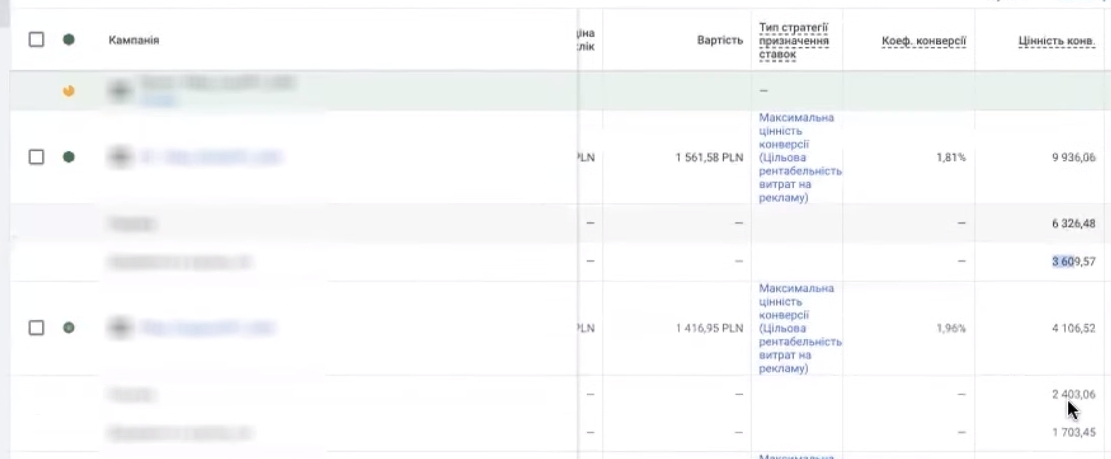
You can see that there were duplicate conversions here. I won’t argue against that here. Gifts with targeting have not been effective enough at all. That is, you can see how much higher the price for conversion of purchases is much less. Basically, there were more test options here. Remarketing campaign, it’s the most tested. Here you see the cost to revenue ratio, revenue optimized would be the best at all. There was a pretty significant number of additions to the cart here. Well, and here you could very quickly reach the limited price per conversion that the client wanted. But it was very few conversions. We had to chase the locomotive in order to have time to make at least some number of pieces to the client. This is not an excuse, but it is a fact.
How many calls and sales will I get by ordering contextual advertising from you?
I need to calculate the conversion of my website Describe
the task
in the application
Calculate potential ad revenue Google
contextual advertising calculator
Plus, I would like to point out this nuance, which is what we are focused on. Our goal is to keep a good enough ratio of these add_to_carts to, more precisely, views, clicks, to add to cart and, accordingly, to these purchases.
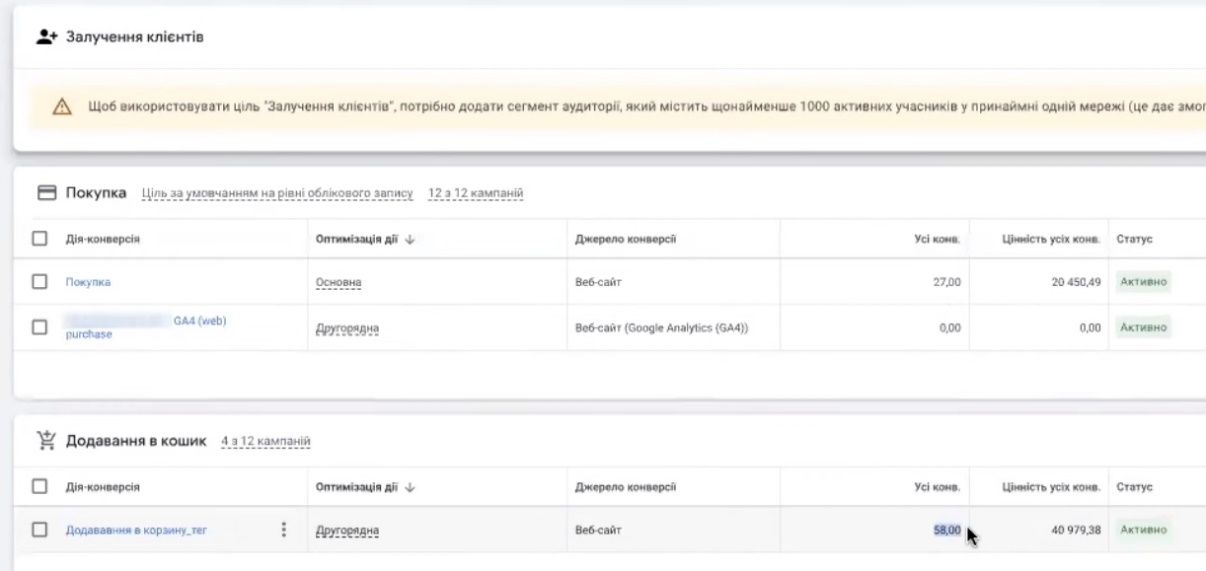
This is one of the biggest challenges, in principle, in these very specific markets that we are launching in. Because this ad campaign, for example, did well in clicks. Everything is fine. Everything’s fine. But additions to the cart are quite low.
Why does performance art need more analytics?
That is, given the buffer period, the first analytics, for example, the same clarity, analytics. What happens after you go to the product card? You see a person who comes in, looks, browses this product card, clicks something there, for example, unfolds descriptions and so on, goes to some more products and completely leaves the site. I mean, you can’t say it’s gluing or anything like that. It’s for the start of a performance, in principle, it’s normal. He’s got to go into the auction to try to get started. So why does Google say collect analytics, collect analytics.
Because the more of it, the more presentable it is, the more likely it is to hit the right people. We have an audience of all the people who buy so similar products, direct products like ours. They are all bombarded by the target query, but only a certain, significant part of that audience can fit our KPIs. That’s the specificity of that performance, that it needs more analytics to fit into that, into that segment of the audience that we need, not just across all the targeting. Or he didn’t get into the right targeting, then basically normal adequate targeting, even by competitors. Plus or minus he had enough expediency.
Launching a campaign without objects
Okay. What can we look at next? Maybe, look, you could say that maybe the team did something wrong in the settings. Because, in principle, I love it when we launch variants of advertising campaigns, something in this context.

When we do not have these objects, when there is no temptation for the system to shout out our goods in some CMCs somewhere. And, as a rule, we launch even some types of advertising campaigns without signals. Why no signals? If you have a normal enough feed – there is no point in adding the same keywords to these product cards, if you have them in the feed. Because the system already understands that.
Plus I would like to point out that initially, initially we have these settings, which are now here apparently, rather in this campaign are included. For example, these text ads. Here, for example, these are all things that we also exclude.

Why? So that there is no temptation to very actively go into the system’s DPOs. This is all the functionality of dynamic search ads. Well, text objects were even more actively taken from object groups. Why are we using this?
It’s not pure conventional merchandising. It’s something analogous to smartshopping. That is, it is a combination of product advertising combined with product dinremarketing. But its difference from the dinremarketing of the usual CMC-officer is that really rotate the goods that are available and take into account those goods that a person viewed according to those targeting that we need, signals. So that’s the first nuance.
Effectiveness of launching campaigns with or without objects
Next, in some campaigns, people… This whole story has already been changed here. Added these targeting things, but they’re not going to affect it significantly. Well, I mean, these things won’t have an impact. I mean, if you read, for example, statistical studies. I mean, I love the scientific approach, the digital approach to working with advertising campaigns, if you read the studies of our foreign colleagues, when they equalize a very large number of projects. It’s not a hundred, not two, but it’s thousands of projects with a certain number of conversions, for example, statistically significant. There from 50, from 60 at least for a month, then it turns out that whether you have these objects, or you don’t have these objects at all – it doesn’t matter.
That is, the effectiveness of performances of these feed only (feed only is when you run without objects) or with objects. Their effectiveness is almost identical. The only nuance is that on small budgets and on a small number of conversions, we need to control more tightly where the performance itself goes, so that it is not a lot of gmail or some other kind of advertising that we don’t need. Because the system will be very tempted to use your creatives. Because that’s the easiest thing it can do. Remake their videos and so on. But we don’t know whether these tools can work now in this case. That is, if statistical studies say that there is no particular correlation, plus there is no point in bothering with it. You want approximately commodity audience targeting, then this is the most optimal structure.
What changed in the advertising campaign in the larger period?
Has anything changed in this advertising account? Basically if we take a longer period there, for example. We finished back there at the beginning of January. With a different approach, with different budgets, because there was a little bit more overall budget for advertising campaigns. Well, as you can see, here are the conversions, they remained the same, buying, adding tags, these ad campaigns have been excluded for a long time.
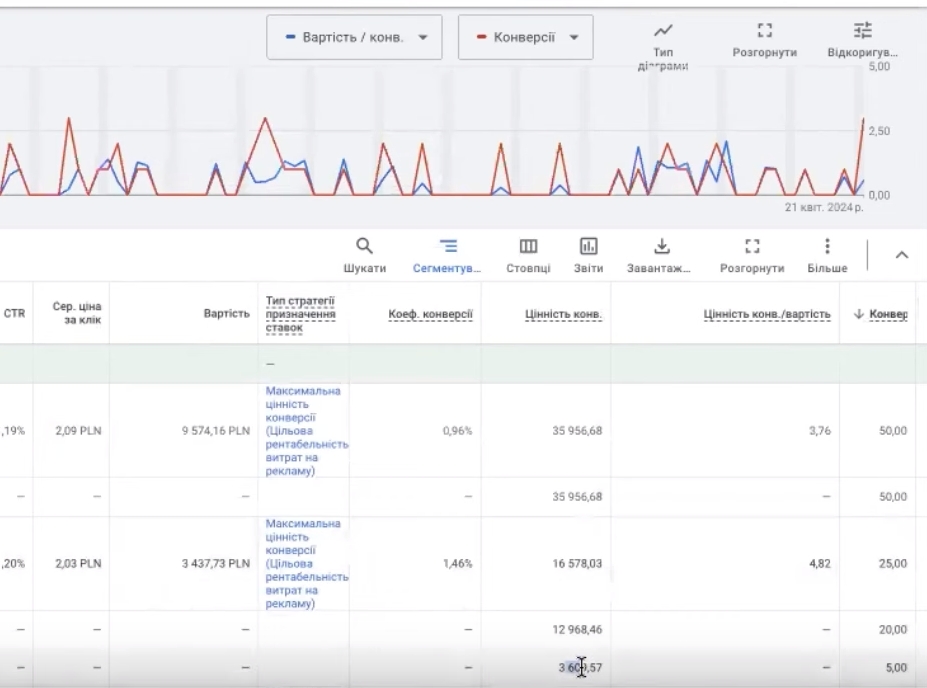
As you can see, nothing has practically changed. The number of conversions at the same time, in this period, was much higher, as you can see. There wasn’t already a cart addition here. There was a lot more. And here it’s sagging.

Perhaps in this case there will be some progress, but so far it is not visible, given the fact that history has been returned to the general structure. That is the rejection of testing, some signals, although here it is necessary to test these signals. Why?
What do you need to focus on to understand movement in the right direction?
Because one of the important nuances, criteria that you need to be guided by in order to realize whether you’re on the right track or not.

Well see, this is where they added the search. This is to look at your auction statistics, if you see that your already desired competitor. Here is the desired one, it is somewhere very low, or there the frequency of crossing with it is not the same, or the percentage of wins, then this is a reference point for you that something has changed in performances.
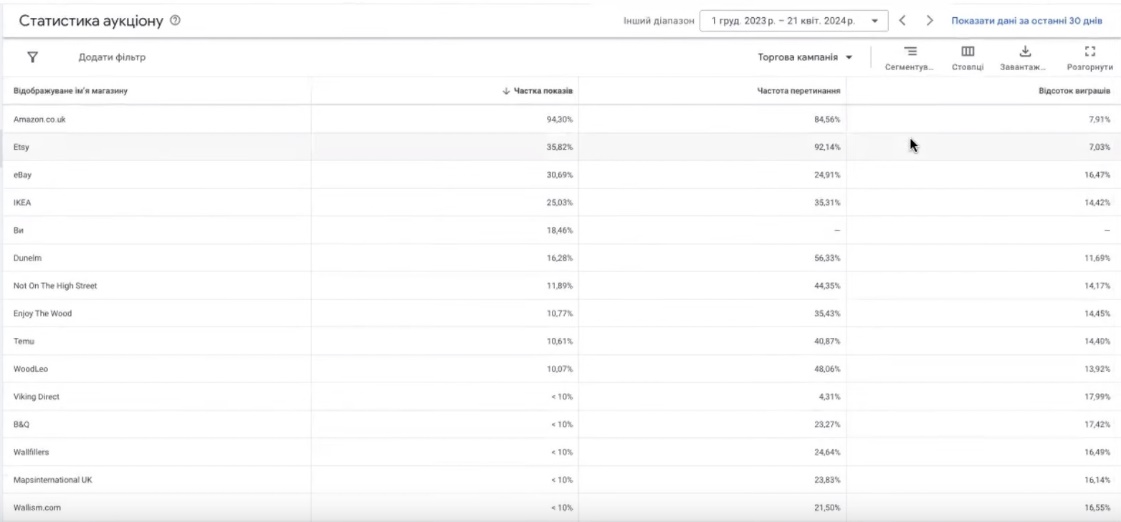
It happens in different situations, even if the performance was generating a very excellent number of conversions before. Then at some point he changes targeting. You can see that he either decreases in impressions or spends less budget. It’s not that we don’t know, we don’t analyze all possible signals that come into the performance at the same time. Maybe there was some shitty traffic somewhere, which ruined everything and he refocused on it.
Fake orders
Here, for example, is what they do with fake orders, where some people, thinking that there millions will mess something up, millions can be tweaked. That’s the problem when they do a lot of very small test on small amounts of orders. It makes the whole situation worse.
But I do not recommend doing this. Because you’re going to get fake orders, you’re going to get fake orders, and you’re going to sit there like two fools in an auction and think, “Oh, my God, what do I do?” That’s not the answer, guys. Better work on your ad campaigns. I know that dirty methods are always welcome. Well, I, for example, do not welcome such things, I generally say no, we will never do such things in our lives.
So why do these fake orders? It’s gonna backfire. A person who makes fake orders, he’s also someone who has made fake orders. You’re gonna get the same kind of publicity. And you’ll be happy with the work? I hope very much so.
Parsing the auction stats why you can’t grow
Here, that is, in the auction statistics you can look at these microperiods and analyze where you are. This is this advertising campaign. Why can’t it grow as a whole? Because that’s where the main competitors, where you’re bombing, you are. Well, for example, in these two. Even the same eBay with Etsy, they’re only 35% in these targeting was only 30%. IKEA is 25% here. For some reason, IKEA crawled out here. So this is not that auction at all. Plus, if you look at this niche in other countries, this auction statistics will be slightly modified there.
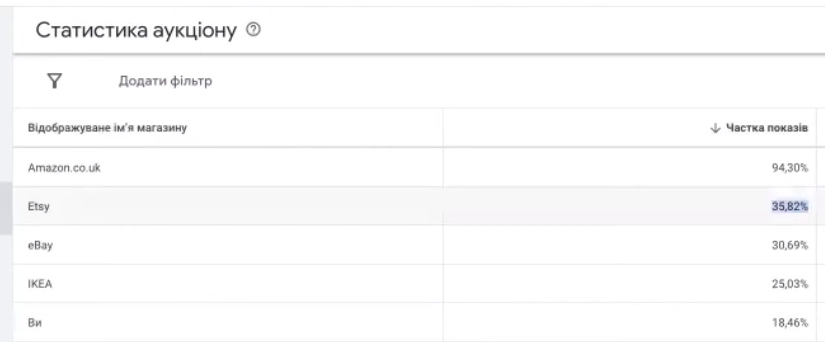
Same thing with this campaign. Here’s the same story. Well, that is, we are competing a little bit with the wrong fellow in these auction statistics. There is a comrade to whom we need to cling, and unfortunately, we can not do without correction of signals. Correction of signals, correction in fidu. Same thing, for example, in point location, here are the geographic ones. There are no statistics in general here.
Results
So, to summarize, you as a client need to understand one important thing. The first thing is that if we go into a very complex market like the UK, you have to be prepared for the fact that the team will have to work a significant amount of time.
And it’s going to be a minimum of 60-90 days there to just build a backbone of stable ad campaigns. Because if you take just the last 30 days, here the price per conversion is much more expensive than what, for example, we were charged in the KPI. Maybe the client has changed their KPI, maybe it needs to be more expensive. Prepare for the fact that it will take a chunk of time. The second thing that is important is that you need to have patience for the fact that in complex projects you will not have to drive a locomotive to achieve these conversions, just stock up. Well, you can see here that the conversion rate here was just higher. This is the result of our work.

Let’s put it this way, the result of pre-collected analytics, because further, as you can see, the conversions are all sagging. And to take into account seasonality, user behavior directly, it must be taken into account. You should also look at the moment, i.e. have patience and just systematically, systematically collect the analytics you need. Because you can shoot some conversion things, collect analytics, add additional goals, redo the technical component, exclude IDs, redo the feed, and so on. But so that it was not an endless game of something, just systematically prepare the technical base and do systematic planned tests. And these tests will lead to systematic growth, as was the case, for example, with the previous sales cases in Germany, for example, I think Germany.
I posted a case study on wooden goods for children. Please be patient. I know things are slipping. Planatically gather new analytics and grow to those volumes or KPIs or ratios that will be profitable for you and continue to grow. Don’t get too excited, don’t rush, don’t give up. This is if we enter a complex project, a complex niche. It can be bought, but as you can see, if you enter the wrong auction, if you play with the wrong participants in an auction, then, of course, this whole story can stretch over a much longer period of time.
Maybe some market you may be disappointed, you may not be disappointed. That’s a different situation, so that’s why I made a minicase like this. What you asked to tell you more of some technical this fat stuff, what affects what, how it works, what results to expect. As you can see, this is not a case study where there’s a lot of immediate sales, they’re super cheap. This is me telling you the other side, which very few specialists will share. Because nobody wants to share bad cases. You don’t want to see, right, bad cases. Everybody wants to see something super, something awesome, cool. But there are other sides to it. Well, if the client had a little bit of patience here, it seems to me that the result would be much better than what has been coming out of the UK market even in the last 30 days.






